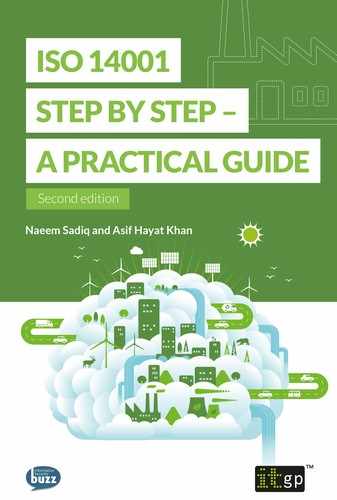CHAPTER 7: OPERATIONAL CONTROLS (CLAUSE 8.1)
What are operational controls?
Operational controls may be defined as ‘measures taken to manage risks’. In the context of an EMS, operational controls will be referred to as ‘the methods and means implemented for managing environmental risks’, where their absence could lead to:
• Deviation from the organisation’s environmental policy, objectives and targets;
• Violation of specified legal or other applicable requirements; and/or
• Environmental pollution.
The following diagram explains the requirement of operational controls:

Figure 4: Operational controls
Types of operational controls
Operational controls may be broadly categorised as administrative controls or engineering controls.
Administrative controls include:
• Written procedures or instructions (operations, waste/effluent/emission/hazardous substance management, utilities, etc.);
• Competence or training requirements;
• Permit to work (PTW);
• Own or contractor’s environmental control procedures (induction or refresher training, meetings, inspections, access controls, PTW systems, etc.);
• Inspection and maintenance programmes;
• Solid waste disposal procedures;
• Fire watch;
• Emergency preparedness procedures and drills;
• Spill control and treatment procedures (equipment, neutralising substances, kits, etc.); and
• The use of personal protective equipment (PPE).
Engineering controls include:
• Isolation and enclosure of environmentally hazardous materials;
• Containment walls for hazardous liquids (chemicals, flammables);
• Leak detection and alarm systems;
• Electronic or mechanical interlocks to prevent emissions, overflows or spills;
• Line evacuation systems (pigging, etc.) to minimise solid waste and water consumption;
• Smoke/fire detection and suppression systems such as auto sprinklers;
• Plant safety devices (visual controls and indicators, non-return valves, pressure relief systems, etc.);
• Emergency shutdown systems;
• Effluent treatment plants; and
• Scrubbers and sprays to reduce particulate matter and other hazardous gases from emissions.
While selecting operational controls, the organisation should consider the following hierarchy:
• Elimination (e.g. lead-free petrol, chrome-free leather).
• Reduction (recycle, reuse or substitute, e.g. reducing paper thickness in packaging, recycling grey water for plantation, reusing printing toners, substituting incandescent bulbs with LED lights).
• Isolation (enclosure/segregation, e.g. building a containment wall around fuel storage, separate containers to collect different types of wastage).
• Control (through administrative and/or engineering controls).
• Defences (e.g. PPE, emergency procedures, fire-fighting, spill management).
